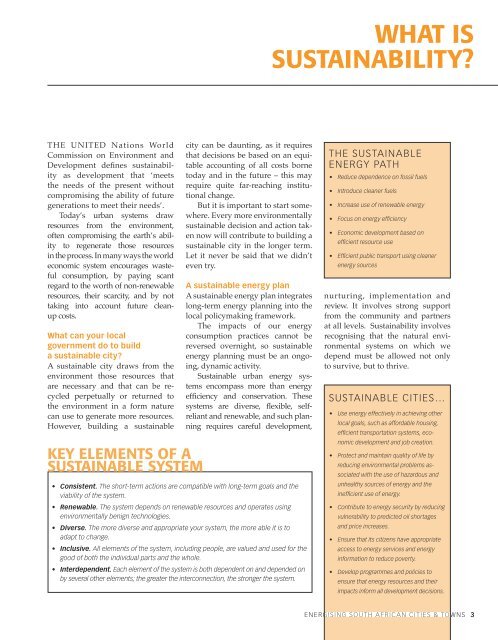Energising South African Cities & Towns - City Energy Support Unit
Energising South African Cities & Towns - City Energy Support Unit
Energising South African Cities & Towns - City Energy Support Unit
Create successful ePaper yourself
Turn your PDF publications into a flip-book with our unique Google optimized e-Paper software.
WHAT ISSUSTAINABILITY?THE UNITED Nations WorldCommission on Environment andDevelopment defines sustainabilityas development that ‘meetsthe needs of the present withoutcompromising the ability of futuregenerations to meet their needs’.Today’s urban systems drawresources from the environment,often compromising the earth’s abilityto regenerate those resourcesin the process. In many ways the worldeconomic system encourages wastefulconsumption, by paying scantregard to the worth of non-renewableresources, their scarcity, and by nottaking into account future cleanupcosts.What can your localgovernment do to builda sustainable city?A sustainable city draws from theenvironment those resources thatare necessary and that can be recycledperpetually or returned tothe environment in a form naturecan use to generate more resources.However, building a sustainableKEY ELEMENTS OF ASUSTAINABLE SYSTEMcity can be daunting, as it requiresthat decisions be based on an equitableaccounting of all costs bornetoday and in the future – this mayrequire quite far-reaching institutionalchange.But it is important to start somewhere.Every more environmentallysustainable decision and action takennow will contribute to building asustainable city in the longer term.Let it never be said that we didn’teven try.A sustainable energy planA sustainable energy plan integrateslong-term energy planning into thelocal policymaking framework.The impacts of our energyconsumption practices cannot bereversed overnight, so sustainableenergy planning must be an ongoing,dynamic activity.Sustainable urban energy systemsencompass more than energyefficiency and conservation. Thesesystems are diverse, flexible, selfreliantand renewable, and such planningrequires careful development,• Consistent. The short-term actions are compatible with long-term goals and theviability of the system.• Renewable. The system depends on renewable resources and operates usingenvironmentally benign technologies.• Diverse. The more diverse and appropriate your system, the more able it is toadapt to change.• Inclusive. All elements of the system, including people, are valued and used for thegood of both the individual parts and the whole.• Interdependent. Each element of the system is both dependent on and depended onby several other elements; the greater the interconnection, the stronger the system.THE SUSTAINABLEENERGY PATH• Reduce dependence on fossil fuels• Introduce cleaner fuels• Increase use of renewable energy• Focus on energy effi ciency• Economic development based oneffi cient resource use• Effi cient public transport using cleanerenergy sourcesnurturing, implementation andreview. It involves strong supportfrom the community and partnersat all levels. Sustainability involvesrecognising that the natural environmentalsystems on which wedepend must be allowed not onlyto survive, but to thrive.SUSTAINABLE CITIES…• Use energy effectively in achieving otherlocal goals, such as affordable housing,effi cient transportation systems, economicdevelopment and job creation.• Protect and maintain quality of life byreducing environmental problems associatedwith the use of hazardous andunhealthy sources of energy and theineffi cient use of energy.• Contribute to energy security by reducingvulnerability to predicted oil shortagesand price increases.• Ensure that its citizens have appropriateaccess to energy services and energyinformation to reduce poverty.• Develop programmes and policies toensure that energy resources and theirimpacts inform all development decisions.ENERGISING SOUTH AFRICAN CITIES & TOWNS3












